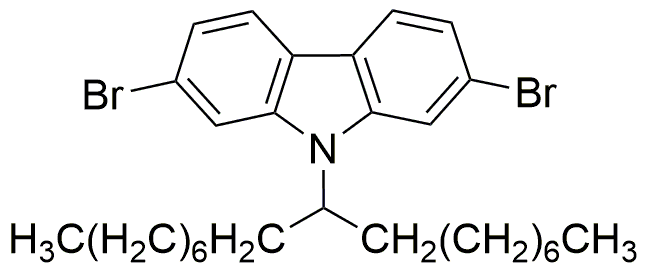2,7-Dibromo-9-(9-heptadecyl)carbazole is widely utilized in research focused on:
- Organic Electronics: This compound is used in the development of organic light-emitting diodes (OLEDs) and organic solar cells, providing enhanced efficiency and stability compared to traditional materials.
- Photovoltaic Applications: Its unique structure allows for improved light absorption and energy conversion in solar panels, making it a valuable component in renewable energy technologies.
- Fluorescent Dyes: The compound serves as a fluorescent marker in biological research, aiding in imaging and tracking cellular processes with high specificity and sensitivity.
- Polymer Additives: It is incorporated into polymers to enhance thermal stability and mechanical properties, which is beneficial in manufacturing durable materials for various industrial applications.
- Research in Photonics: The compound's properties make it suitable for applications in photonic devices, contributing to advancements in telecommunications and data transmission technologies.
General Information
Properties
Safety and Regulations
Applications
2,7-Dibromo-9-(9-heptadecyl)carbazole is widely utilized in research focused on:
- Organic Electronics: This compound is used in the development of organic light-emitting diodes (OLEDs) and organic solar cells, providing enhanced efficiency and stability compared to traditional materials.
- Photovoltaic Applications: Its unique structure allows for improved light absorption and energy conversion in solar panels, making it a valuable component in renewable energy technologies.
- Fluorescent Dyes: The compound serves as a fluorescent marker in biological research, aiding in imaging and tracking cellular processes with high specificity and sensitivity.
- Polymer Additives: It is incorporated into polymers to enhance thermal stability and mechanical properties, which is beneficial in manufacturing durable materials for various industrial applications.
- Research in Photonics: The compound's properties make it suitable for applications in photonic devices, contributing to advancements in telecommunications and data transmission technologies.
Documents
Safety Data Sheets (SDS)
The SDS provides comprehensive safety information on handling, storage, and disposal of the product.
Product Specification (PS)
The PS provides a comprehensive breakdown of the product’s properties, including chemical composition, physical state, purity, and storage requirements. It also details acceptable quality ranges and the product's intended applications.
Certificates of Analysis (COA)
Search for Certificates of Analysis (COA) by entering the products Lot Number. Lot and Batch Numbers can be found on a product’s label following the words ‘Lot’ or ‘Batch’.
*Catalog Number
*Lot Number
Certificates Of Origin (COO)
This COO confirms the country where the product was manufactured, and also details the materials and components used in it and whether it is derived from natural, synthetic, or other specific sources. This certificate may be required for customs, trade, and regulatory compliance.
*Catalog Number
*Lot Number
Safety Data Sheets (SDS)
The SDS provides comprehensive safety information on handling, storage, and disposal of the product.
DownloadProduct Specification (PS)
The PS provides a comprehensive breakdown of the product’s properties, including chemical composition, physical state, purity, and storage requirements. It also details acceptable quality ranges and the product's intended applications.
DownloadCertificates of Analysis (COA)
Search for Certificates of Analysis (COA) by entering the products Lot Number. Lot and Batch Numbers can be found on a product’s label following the words ‘Lot’ or ‘Batch’.
*Catalog Number
*Lot Number
Certificates Of Origin (COO)
This COO confirms the country where the product was manufactured, and also details the materials and components used in it and whether it is derived from natural, synthetic, or other specific sources. This certificate may be required for customs, trade, and regulatory compliance.

